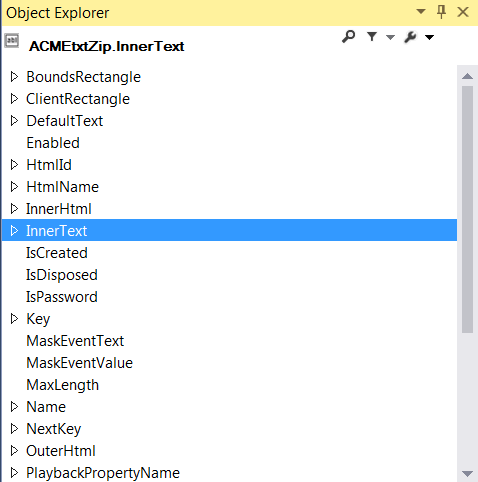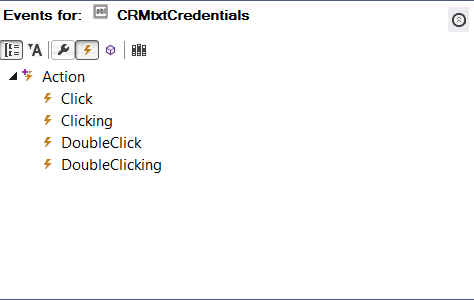Object Explorer
The Object Explorer contains a hierarchy of interrogated controls, automations, components, services, and Windows form/Application bars. The Object Explorer window contains these parts:
Object Hierarchy – The top panelists in hierarchy form project items and associated controls and components. The controls appear with icons that display the matching status and the clone instances.
Note: The Folder, Context, and Configuration project items do not appear in Object Explorer.
Object Inspector – Provides access to the properties, methods, and events for the objects in the Object Explorer hierarchy tree.
While interrogating an application, the matching status of the controls created during interrogation is displayed in Object Explorer. Green check marks appear on the matched control as shown below.
![]()
See the Interrogation and Matching of Windows and Web Applications topic for more information on matched controls.
Some objects in Object Explorer may appear with a red II mark to indicate keying has been enabled for the object (UseKeys property set to True). An example is shown here:
![]()
See the Cloneable Controls topic for more information.
Studio lists the project objects in Object Explorer in a hierarchy created by the relationships between the target controls within the interrogated application. For example, if you interrogate a text box in a Windows application that exists on a panel, Studio matches and creates controls for both the text box and the panel. When you open an Adapter project item in the Designer, Object Explorer shows only those controls related to the particular adapter. When you open an automation in the Designer, Object Explorer shows controls and objects available for all project controls and components.
Note that objects are not created for the application (process) associated with the adapters. For example, if the project contains the Windows adapter set for the Calculator application (calc.exe), the calc.exe process control is not created and added to Object Explorer. This enables Global webpages and top-level forms to be matched to targets in any processes within the adapter. If you need to use process control properties, methods, or events in your project, you can create a process control for an application using the Create Control function on the Windows, Web, or Java tab during interrogation. See the Create Controls Function and Java Controls Tab topics for more information.
Object Explorer function buttons
These functions are available from Object Explorer:
Name |
Description |
Search Object Explorer
|
This function lets you search the Object Explorer tree for a particular control or component. Click the Hide Search Region button to toggle the Find object function on and off. When you enable this function, a text box displays at the bottom of Object Explorer for you to enter the name of the object you want to find. As you begin typing in the Find text box, Studio highlights matching objects in the Object Explorer tree. Click the up or down arrows to initiate the search in the selected direction within hierarchy. |
Filter Object Explorer |
Click the Filter Objects arrow to show a list of all main nodes of the Object Explorer hierarchy. See the example below for a project with a Web application and Windows form:
Click on a project item in the list to include (checked) or exclude (unchecked) the project item and its child objects from appearing in the Object Explorer tree. Note: When an adapter is active in the Designer, Object Explorer shows only the controls applicable to that adapter. |
Explore Component Properties
|
This function lets you display a list of all properties for an object in the hierarchy and access the inherited properties and methods for a selected object property. By default, the Object Explorer hierarchy lists the controls within the project. Highlight an object in the hierarchy and click the Explore Component Properties button to list properties for the highlighted control. You can access inherited properties for by highlighting a property in the hierarchy and using the Object Inspector. To return to the default view listing the project controls, click the Explore Component button. An example of the properties hierarchy view is shown here for a web application text box control:
|
Object Explorer context menu options
These options are available when you right-click on Object Explorer hierarchy objects. Note that some options are only available during interrogation.
Menu Function |
Description |
Navigate To |
Applies to: Adapters, automations, global containers, controls, web pages, web browsers, and factories Opens the Navigation window listing the project items where the object is used. For more information, see Navigator. |
Validate Connections |
Applies to: Adapters, automations, and global containers Checks for references to missing components and controls. Notification of connection validation results are displayed in the Navigator window. For more information, see Navigator. |
Open |
Applies to: Adapters, automations, and global containers Opens the selected project item in the Designer pane. |
Expand All |
Applies to: Adapters, automations, global containers, and group headings Expands the hierarchy under the selected project item displaying the child objects. |
Delete |
Removes the object and related child objects from the project. |
Highlight (enabled during interrogation) |
Applies to: Controls, web pages, and web browsers (during interrogation) Displays a rectangle flash around the object in the application. |
View Source (enabled during interrogation) |
Applies to: Web controls (during interrogation), web pages, and web browsers Opens a read-only text dialog showing the HTML associated with the web object. |
Add Context Menu Items (enabled during interrogation) |
Applies to: Window application controls and the web browser (during interrogation) Opens the Add Context Menu Items dialog for selecting context menu items for use in the project. For more information, see Adding Context Menu Items. |
Add Control Regions (enabled during interrogation) |
Applies to: Window application controls and the web browser (during interrogation) Opens the Control Region Editor for the selected object. For more information, see Adding Control Regions. |
Add Menu Items (enabled during interrogation) |
Applies to: Forms (during interrogation) Opens the Add Menu Items dialog for selecting menu items for use in the project. |
The Object Inspector in the bottom pane of the Object Explorer window provides access to the properties, methods, and events associated with the objects in the Object Explorer hierarchy. Commonly used properties, methods, and events for specific object types appear in Object Inspector based on a Studio configuration file. For more information, see Additional Configuration Files.
Use the Object Inspector to access additional properties, methods, and events for the project objects. Note that Design properties appear in the Properties Grid window for project objects. The Design properties are those such as Name, UseKeys, and Timeout which you set when developing the project and are not changed through automation logic.
These Object Inspector functions are available:
Name |
Description |
Categorized |
Click the Categorize button to list object properties, methods, or events according types. For example, a Windows application text box control properties and events categorized appear as follows.
|
Alphabetic |
Lists the properties, methods, and events alphabetically. |
Properties |
Lists the commonly used properties for the object. |
Events |
Lists the commonly used events for the object. |
Methods |
Lists the commonly used methods for the object. |
Configure Type |
Opens the Component Configuration dialog to browse and select all available properties, methods, and events for an object. For more information, see Configure Type Dialog. |




